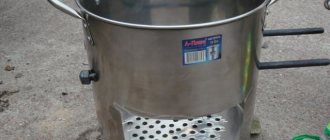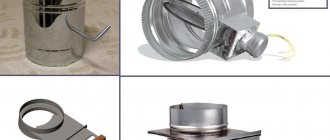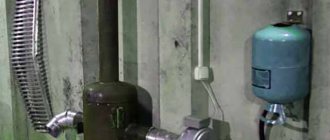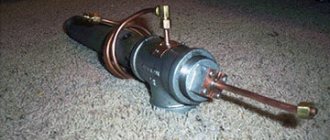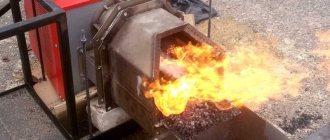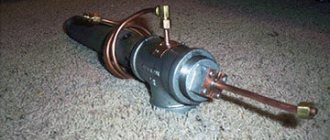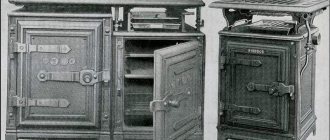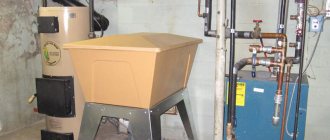Home / Burners for boilers
Back
Published: 06/25/2020
Reading time: 5 min
0
1848
A pellet burner is a modern energy-efficient device designed to use a special fuel for solid fuel boilers - pellets.
The main advantages of this type of boiler equipment are considered to be the high efficiency of the heating unit due to the complete combustion of pellets and the possibility of 100% automation of the combustion process using innovative diagnostic and control tools.
Modern household welding and plumbing tools allow the home craftsman to make a pellet burner with his own hands.
- 1 Design and principle of operation of a pellet burner 1.1 Gravity burners
- 2.1 Creating a drawing of a pellet burner with dimensions
About the pellet burner
A pellet burner is a special heating device that produces heat by burning pellets or fuel granules in a boiler. In some cases, these burners use unnecessary dry grain.
There are manual and automatic burners; in automatic burners, fuel is supplied to the combustion hopper using a special auger, and the entire process is controlled by sensors, due to which the device requires minimal control from the user. Pellet burners have found their use not only in everyday life, but also in industry. They are used for space heating, water heating and to meet a number of other needs.
Pellets, or fuel granules, are a special solid fuel that is obtained from wood or agricultural waste by pressing and granulating under high temperatures.
Pellets are an environmentally friendly type of fuel, since when they are burned, the same amount of carbon dioxide is released into the atmosphere as is formed during the natural decomposition of wood
In countries where agriculture and the woodworking industry occupy leading positions, the cost of pellet fuel is much lower than that of coal. The only exceptions are those regions in close proximity to which coal mining enterprises are located.
When burning pellets, hazardous fumes are not released, as happens when burning liquid fuel.
Principle of operation
All pellet installations that can be purchased in the store are equipped with additional components:
- Auger – supplies fuel from the bunker to the combustion chamber;
- Controllers for automating the work process;
- Bunker – the place where the fuel is located before being supplied to the combustion chamber;
- A lambda probe is a special sensor that monitors the oxygen content in smoke chambers and independently controls the fuel combustion process depending on conditions.
The pellet burner must be protected with a plastic corrugated pipe. It acts as a fuse when reverse draft occurs. If the fire begins to move towards the bunker, the pipe burns out, preventing the flame from spreading.
Additionally, a fan is used, which enhances the combustion of pellets by pumping air, as well as a thermoelectric heater, which allows the fuel to be ignited without human intervention.
In automated devices, pellets are fed into the combustion chamber automatically; a person is only required to monitor the amount of fuel in the bunker. The need to supply fuel to the combustion chamber is determined using temperature sensors (they can monitor the air temperature in the room, the water temperature, or any other environmental indicators depending on the operating mode of the equipment).
The required temperature of the coolant is set by the user, all further increases and decreases are controlled using automated equipment. As soon as the temperature reaches the set level, the burner begins to operate in standby mode (the pellets do not go out, they begin to smolder). If the temperature, on the contrary, drops, the controller activates the built-in fan. Under the influence of air, the pellets flare up and the burner goes into operating mode. If during downtime the pellets go out for any reason, the heating element is activated, which re-ignites.
Why pellets
For those regions where gas is not available, such biofuel is a salvation. It is very effective and has a reasonable cost. For comparison: burned 1 kg of pellets release thermal energy equal to 0.5 liters of diesel fuel. They are capable of delivering 5 kW/h. To heat a one-story house in an area with moderate winters, you need 50 kg of pellets per day. The advantage of fuel is that it can be filled once for several days. It all depends on the boiler model. Pellets are loaded into a hopper, and then they are fed into the burner itself. A DIY pellet burner requires maintenance twice every 7 days.
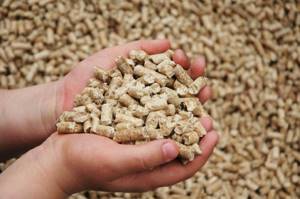
If we talk about the disadvantages of this solid fuel and burners, then this is the possibility of reverse draft. In this case, the fire will burst into the bunker. The result is a fire in the house. The second point concerns the quantity and intensity of air supply. Pellets are lightweight, which means that the air flow sometimes blows them away from the device. Then they won't burn. And when the air supply is small, the fuel does not burn completely. In order for the burner and oven to function correctly, it is important to follow the sequence.
You need to light the fuel with a ceramic rod lighter. It doesn’t just apply direct fire to the raw materials, but heats up to more than 1 thousand degrees. This is done so that during ignition the flame does not go into the hopper with other pallets. Then air is supplied inside so that the combustion flame remains stable and even. After this, the operating mode is reached, since a large amount of air is supplied inside. The process can be stopped by stopping the air supply to the burner.
Device
Any burner has one goal - creating a powerful flame to heat the air or water jacket of the boiler. At the same time, the combustion power itself can be adjusted independently.
A pellet burner has similar goals. The device is a wind tunnel into which solid fuel is supplied and air is pumped for combustion. Fuel is supplied to the pipe using a special screw-type conveyor. The fuel itself is located in the loading hopper before combustion. The bunker can have a different volume, and it depends on the volume how long the burner can burn on its own without human intervention (adding fuel).
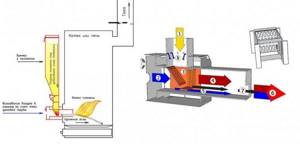
Pellet burner structure: 1 - The pellet enters the burner under the influence of gravity; 2 - Air enters the burner due to the vacuum created by the draft of the chimney; 3 - Pellet combustion occurs in the combustion chamber, which is called the “basket”; 4 - Due to the high temperature, thermal decomposition of wood occurs in the basket, which forms a flow of flammable gases; 5 - A secondary air flow passes under the basket; 6 - In the burner nozzle, the flow of combustible gases and secondary air mixes, forming a torch; 7 - Solid combustion products are ejected from the burner into the ash pan of the boiler or furnace by a stream of secondary air; 8 - Ventilation of the supply channel does not allow hot gases to diffuse up the channel and destroy the pellets, ensuring a stable supply of pellets.
Air is forced into the combustion zone by means of a fan.
The combustion chamber in the burner can be round or rectangular. Round burners are the most common due to their ease of manufacture. A pipe connection is attached to the outside of the combustion chamber, through which fuel is supplied from the conveyor.
The design also includes an ash pit in which combustion waste accumulates. During the combustion of pellets, a little ash is formed, so you need to clean the ash pan no more than once a week when the burner is actively used.
Types of heat exchangers for pellet stoves
The design of a long-burning pellet stove can include two types of heat exchangers to which heat is transferred from the flue gases:
- water tube;
- fire tube
In a water-tube heat exchanger, water is heated from pipes heated during the combustion of pellets. But hot carbon monoxide passes through the fire tube circuit, and the combustion energy is transferred to the water jacket. This is not the most popular type of heat exchanger for a solid fuel boiler.
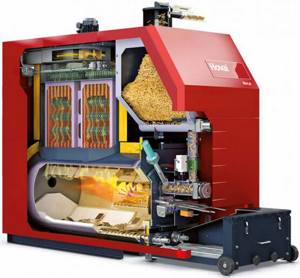
Its efficiency can be increased if it is made two- or three-pass, that is, thermal energy will move through the pipes, changing direction 2-3 times and passing several circles. As a result, the water jacket absorbs the maximum amount of heat, and the exiting smoke will be heated to 150 ℃.
To make it clearer, we will describe the operating principle of an automatic pellet stove with a fire tube heat exchanger. So, the burner burns solid fuel, as a result of which the walls of the fuel chamber and the coolant inside the boiler casing heat up. Carbon monoxide is evacuated under the influence of draft and fan through flame tubes, also transferring heat to the water jacket, after which it finally exits into the chimney. The combustion intensity is determined by the controller, which relies on data received from the temperature sensor. It is lowered into water at the outlet of the boiler.
Torch pellet burner: manufacturing
Unlike a gravity burner, a flare burner is equipped with a screw conveyor, a fan and an electronic controller, which significantly increases the material costs of manufacturing the unit. Despite this, this design has become widespread due to the following advantages:
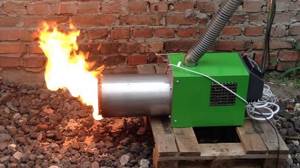
- High performance;
- Unpretentiousness to the quality of the granules used;
- Possibility of working in autonomous mode, while the duration of operation is determined solely by the capacity of the fuel bunker;
- High degree of fire safety.
To make a fecal pellet burner with your own hands, you will need to purchase:
- Low-speed electric motor (or two, depending on the design of the feed mechanism);
- A fan that will provide forced air supply to the combustion chamber;
- An electronic controller that monitors changes in coolant temperature and sends corresponding signals to the actuators of the device.
As for the manufacturing process itself, it is much more complicated than the manufacturing process of a gravity burner, since it becomes necessary to install temperature sensors and connect an electronic control system. The materials for manufacturing the unit do not differ from the previous version.
Making your own boiler
How to make a Babington burner
The first stage involves creating a project. Diagrams and drawings should be provided here, as well as the order of assembly of the elements.
In addition, you need to purchase basic components.
- Pellet burner. Experts recommend giving preference to a factory-made element, because making a burner yourself is quite difficult. This is explained by the fact that the product ignites the fuel and regulates the flame.
- Sensors They are responsible for the economical consumption of the selected fuel, and also create an optimal temperature regime in the home.
- Frame. This part of the boiler should be placed horizontally, which will allow efficient use of the generated heat. To create a boiler body with your own hands, steel, cast iron or brick are suitable. The selected material must retain heat for a long time and transfer it to the heat exchanger.
- Heat exchanger. It is located in the body itself. To complete this you will need a coil or several pipes. They are connected to the heating system. It is also necessary to take care of the inlet for cold water, which will be poured into the heat exchanger.
- The combustion chamber. Such an element must have a diameter corresponding to the size of the purchased pellet burner.
- Fuel bunker. This is where you will store the fuel. From here it will go to the burner.
It is important to additionally prepare the ash pan, chimney, auger and electric motor. An auger is inserted into the unloading part of the housing, and then a plastic pipe is fixed, through which the pellets will reach the burner
As soon as the corresponding signal is received, the operation of the electric motor will begin. It will stop only when the combustion chamber is filled with heat
An auger is inserted into the discharge part of the housing, and then a plastic pipe is fixed through which the pellets will reach the burner. As soon as the corresponding signal is received, the operation of the electric motor will begin. It will stop only when the combustion chamber is filled with heat.
If you want to make a pellet boiler with your own hands, be sure to prepare drawings and buy a ready-made burner, which will help you avoid basic mistakes and really save on the device. At the same time, you will provide your home with heat, avoiding significant heating costs.
Retort pellet burner: manufacturing
The supply of granular fuel in such devices, as well as in flare devices, is carried out using a screw conveyor. The difference is that the granules are fed from below. The air required for combustion is forced through special holes in the walls of the retort. For the effective operation of such a device, a controller is required that promptly responds to changes in coolant temperature and makes the necessary adjustments to the operation of the auger and fan.
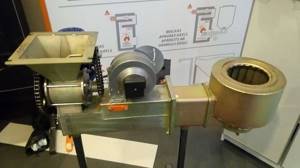
Unlike flare devices, the flame in a retort pellet burner is directed upward, so the design of the heat exchanger for these units is very different. The disadvantages of retort systems include:
- Possibility of frequent clogging of the air duct openings, leading to attenuation of the device;
- The need to manually clean the retort from combustion products and granulated fuel residues;
- No gaps in the supply of granules. If reverse draft occurs, the possibility of ignition of the pellets in the bunker remains.
Heat-resistant steel and cast iron can be used as the material for the bowl. In some models, the retort can be made of ceramic concrete or fireclay.
The complexity of manufacturing such a device at home is quite high, since in addition to plumbing and welding work, skills in connecting electronic control systems will be required.
Do-it-yourself automation for a pellet burner
The most difficult stage in the manufacture of a pellet burner is the manufacture and installation of electronic control modules. If we consider this issue from a theoretical point of view, if you have special knowledge, you can make a controller yourself, but in practice this is almost impossible. In addition, the cost of components will reduce cost savings to a minimum, and the result may be very questionable. Therefore, even if you make your own burners, controller, sensors and other automation, it is better to purchase them in a specialized store.
For efficient operation of the burner, the automation must provide:
- Dosage of pellet supply and control of the screw conveyor;
- Automatic ignition and extinguishing;
- Adjusting the air supply by changing the fan speed;
- Estimation of the amount of coolant in the heating circuit;
- Control of coolant temperature in the boiler water jacket;
- Assessment of draft parameters in the chimney.
Failure to comply with even one of these conditions can lead to failure of not only the heating boiler, but also the entire heating system.
Making a pellet burner is a labor-intensive and responsible process, however, if you have the necessary knowledge and equipment, it is quite possible to make such a device yourself. Particular attention should be paid to the selection of parameters and installation of electronic control systems; the efficiency of the boiler will depend on the correctness of their operation.
Is there any point in doing this?
Often, a person who wants to install such a unit in his home is faced with the question of whether he needs to assemble a pellet stove with his own hands or whether it is best to purchase a ready-made option. It must be remembered that in the first case, a person will be able to create a unit that will fit the existing conditions in all respects, and in the second, he will have to use a structure that is ready for use, but does not take into account the individual characteristics of the room. If doubts are caused by the type of fuel used, then you need to know that pellets are a type of processed wood and agricultural waste, which makes the fuel efficient in terms of heat generation, but economical in cost. Such a homemade stove is environmentally friendly because:
- does not pollute the air;
- does not contain harmful components in vapors;
- do not require special fuel supplies, which eliminates the need to cut down trees.
It is important to remember: pellets must be stored in special conditions, as they ignite very easily, which can cause a fire in the room. Having weighed all the pros and cons, a person will be able to understand whether it makes sense for him to make such a boiler with his own hands or purchase one already ready for use.
After weighing all the pros and cons, a person will be able to understand whether it makes sense for him to make such a boiler with his own hands or purchase one already ready for use.
Gravity pellet burners
Such designs are easier to handle. Their great advantage is their ability to operate even without power supply. The principle of operation of the device is to pour pallets into the firebox under their own weight. The behemoth pellet burner and the pelletron pellet burner are prominent representatives of gravity products. You can put them into operation by adjusting the supply damper and the draft regulator on the chimney. The disadvantage of the design is that the pellets in the bunker can ignite.
To solve the fire hazard issue, manufacturers install thermal dampers on burners of this type. When the flame breaks out from the hearth and moves towards the bunker, a special gateway comes into play. It is heat activated. The airlock serves as a fire barrier. Another protection option is a double grate. This is a simple mechanism consisting of two parts. The upper one approaches the pellets and picks up a certain amount of them. Then the part moves towards the flame. The second part begins to dump ash into the receiver.
Advice! For a double grate it is also recommended to install a fire sluice. The mechanism may jam, and the fire will penetrate the pellets loaded into the hopper.
Making a burner with your own hands
How to make a pellet burner? The combustion chamber is made of steel pipe. Wall thickness – 4 mm no less. The steel is heat-resistant and can withstand high temperatures. Attachment to the boiler unit body is carried out using a flange plate. For manufacturing you will need 3 mm steel. It is better to buy a conveyor for feeding pellets or use an auger.
To rotate the mechanism, you need bearings, a low-speed motor (electric) and a gearbox. A fan for supplying air can be purchased at the store. It is fixed on the plastic, in which the place has already been prepared. The plate is made based on the drawing. The configuration depends on the boiler door itself. A drawing of the burner can be seen in this photo.
A mandatory step is to adjust the amount of incoming pellets and air. Without this, the device will work unstably or constantly at full power. To change the intensity of the fan and auger, you can install a manual regulator. In this case, you will have to constantly monitor and adjust the burner, taking into account the temperature of the coolant and air.
It is important that during various work processes, fuel and air are correctly selected. Only then will the torch be even and stable. To do this, you cannot do without an automated device. You will need a control unit. The burner controller has free control contacts, to which the electric motor from the screw and fan is connected.
To automate the ignition of pellets and control the flame, you cannot do without a photosensor and an electric incandescent element. A photo sensor monitors the appearance of a stable flame and notifies the controller. It will turn off the filament element. But an incandescent element is needed to ignite the pellets. The supply pipe is equipped with a filling sensor. It stops feeding pellets when the auger and top pipe are full.
Description of operating modes
The very principle of operation of a pellet burner is as follows: a portion of fuel enters the chamber, it is ignited and the minimum air supply is turned on. As the fuel burns and the chamber warms up, more air is forced in. As a result, a stable, even flame appears, heating the heat exchanger with water. In factory burner devices, the process is fully automated, ignition is provided by an electric incandescent element, and its operation is controlled by a photosensor. The amount of air and pellets supplied to the chamber is regulated by an electronic unit, receiving signals from temperature and pressure sensors. A diagram of a pellet burner will help you understand how the device works.
Fuel in the form of wood pellets or seed husks can be supplied to the pellet burner auger in various ways:
- The traditional method is to supply pellets from a separate large hopper so that its capacity is enough for at least 7 days of operation of the boiler, which needs to be cleaned once a week. From the bunker, the fuel is moved to the burner device by an additional screw conveyor of the required length.
- A DIY gravity pellet burner can be equipped with a simpler fuel supply. In it, husks and granules are poured under their own weight into an auger from a hopper installed directly above the burner device, which delivers the required amount into the combustion chamber. Then the power reserve of the boiler will be from 1 to 3 days, depending on the intensity of work.
Forced fuel systems
It is the method of fuel supply that determines the fire safety of a boiler with a pellet burner. In general, pellets can be fed into the burner by force or by gravity, when they themselves pour out of the hopper. The safest method is forced. However, this is exactly the case when you have to pay for safety and convenience: forced-feed burners are the ones that cost from $3000.

Pellet boilers with forced fuel supply and burners for them
Forced pellets to the boiler from the bunker can be pneumatic lift (item 1 in the figure and auger (item 2 and see below). What they have in common is that there is an ascending branch in the fuel supply path. If the fire comes out of the burner, then it to get into the bunker, you will need to go down, which is unlikely. Pneumatic supply completely eliminates combustion leakage into the bunker, since there is no solid mass of pellets in the fuel line, and the air blows towards the possible path of fire, so boilers with pneumatic supply can be powered from open bunker, which is loaded once a month. However, in both cases, a cup burner is needed (volumetric, see below) with a screw feed of pellets from the feeder, positions 3 and 4; it is technically complex, and its cost is at least 1/ 3 of the entire boiler power system.
Auger feed systems use 2 separate mechanical units (left and center in the figure): a pick-up auger lifts the pellet from the hopper. The fuel then falls into the feeder (receiving hopper) of the burner, where another auger pushes the fuel into the combustion zone. Oddly enough, combustion leakage into the bunker is not completely ruled out, because In the ascending branch of the fuel line, the pellets lie in a solid mass, so the descending section of the fuel pipeline is made of fusible (but not flammable!) or heat-shrinkable material. If the feeder catches fire, it will melt or break off and interrupt the path of the fire. The system with free fall of pellets into the feeder (on the right) is used less frequently due to lower fire safety, but it can be used to power gravity burners, see below.
A serious drawback of systems with forced supply of pellets is their energy dependence: you need to turn 2 electric motors. But then it makes sense to use the burner with forced pressurization, this increases the efficiency of the boiler by 3-7 percentage points, and connect the control automation, see below. In cold countries that heat themselves with imported fuel or their own waste, savings on heating for the season in this case can amount to an amount that pays for the cost of a burner with a boiler.
Burners in forced-feed systems use volumetric screws, i.e. The pellets in them are also forcibly squeezed into the pyrolysis chamber, and the pyrolysis gases are burned in the boiler furnace. Burners with a flame bowl (item 1 in the figure) are gradually falling out of use: if the automation fails (see below), the fuel in the bowl cokes, which means an extraordinary cleaning or repair of the boiler, and the penetration of fire into the feeder is not such a rare occurrence in models from the best manufacturers. When using standard fuel (recommended by the manufacturer), you need to clean the burner with the bowl from any remaining ash once a week.

Methods for supplying fuel from the feeder to the pellet burner
Burners with secondary air supply to the afterburner (item 2) or with a retort that forms primary and secondary flows directly in the bowl (item 3) are free from most of these disadvantages. A burner with an afterburner almost never cokes, but it still needs to be cleaned manually once a week, while a burner with a retort needs cleaning monthly, and only then based on the results of an inspection.
About automation
Burners of systems with forced supply of pellets are not examples for beginners to repeat, not only because of the complex mechanics. All its advantages, incl. safety, they show only under the control of a microprocessor operating from a whole set of sensors:
- In the chimney - it gives not only the presence, but also the amount of draft.
- In the firebox – shows the flame temperature.
- In a heating system, it gives the return temperature.
- In the burner, in the combustion zone - shows the presence and level of fuel.
- Same thing in the feeder.
- Same thing in the bunker.
The microprocessor, guided by data from the sensors, regulates the supply of both fuel and air according to a program specified by the user from the remote control, for example. “Winter”, “Spring/Autumn”, “Lower level of comfort”, “House is empty”, etc. It is the simultaneous coordinated regulation of air and fuel supply that ensures the highest possible efficiency of the boiler using any available pellets; this is a serious advantage of systems with forced supply.
Automation tools
The ratio of air and fuel supply to the combustion chamber must be adjusted, otherwise the operation of the burner device will be unstable or at maximum power all the time. The easiest way to change the speed of the auger and fan motors is to install a simple manual regulator. But then inconveniences will arise in the form of constant supervision and adjustment of the heating unit depending on the temperature of the coolant and the surrounding air. Self-adjusting a pellet burner involves selecting the ratio of air and fuel in different operating modes, at which the flame will be even and stable. Device automation will help achieve this.
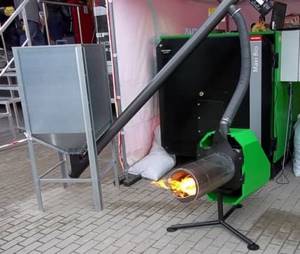
Pellet burner with hopper
First you will need to buy an electronic control unit. If your boiler is already equipped with one, then explore the possibility of using it. As a rule, controllers from leading manufacturers have free control contacts to which fan and auger motors can be connected. In this case, based on sensor signals, the controller will increase or decrease the supply of pellets and regulate the fan speed.
In terms of ignition and flame control, a homemade pellet burner made by yourself can also be automated. You need to buy an electric incandescent element and a photosensor. The first will turn on at the very beginning, igniting the fuel, and the second, when a stable flame appears, will signal this to the controller, which will turn off the glow element.
A filling sensor can be installed on the supply pipe; its role is to send an impulse to the electronic unit when the auger and the upper pipe are filled with fuel to stop the supply of pellets. All these automation means allow you to effectively burn pellets and create a certain comfort when servicing the heating installation. However, there are some disadvantages here:
- A homemade pellet burner cannot be connected to every controller.
- The existing electronic unit of the heating unit is often not suitable for working with ignition and burner control devices, then you will have to buy a new one.
- The cost of manufacturing the device increases.
Good article on the topic: How to make a sawdust boiler
Trouble-shooting
To organize the normal operation of a pellet heating boiler, you first need to choose the right location and carry out proper installation of the heating system. When installing a boiler, the base must be strong, capable of supporting both the weight of the boiler itself and the weight of the pellet hopper.
The floor and walls must be insulated with non-combustible materials. Ventilation and chimney are installed from the same materials.
There are several fairly common boiler malfunctions that can be corrected with your own hands:
- The appearance of sparks from the chimney pipe is usually caused by contamination of the ash pans with combustion products.
- A high level of fuel consumption can be caused by poor quality pellets or a significant decrease in outside temperature.
- Poor heating of the room can occur due to an incorrect calculation of the power of the boiler equipment, if there is an air lock in the heating system, or if there is an insufficient number of batteries.
- The appearance of pops and smoke when opening the heating boiler door is most often caused by contamination of the chimney and flame pipes.
The most complex elements are best purchased ready-made. The grate, burner, fan and electric motor, programmers and sensors, factory-made combustion doors are always much better than equipment assembled at home.
A homemade pellet burner is one of the available ways to optimize an autonomous heating system, especially if a solid fuel boiler is used as a heat source. This device will make it possible to heat your home with almost all types of solid fuel.
How to choose a pellet burner
When choosing a burner device, pay attention to technical characteristics, productivity, degree of automation, etc. It would be a good idea to study the reviews of the owners, and you should take into account not only positive, but also negative comments.
The following recommendations will help you make the right choice:
- Manufacturer - burner devices from European manufacturers are approximately 2 times more expensive than their Russian counterparts. The highest quality products are offered by Kiturami, Ferroli and the German concerns VIESSMANN and BUDERUS. Domestic-made burners are unpretentious in terms of pellet quality and are fully adapted to Russian operating realities. Products are offered by the following manufacturers: Pelletron, Teplodar, Svetlodar and Obshchemmash.
- Automation – there is a certain degree of automation in each burner, but for ease of operation, it is optimal to use systems with a self-cleaning function and an installed flame attenuation controller. A burner with automatic cleaning (as in Svetlobor models) can operate without human intervention for about a month.
- Type of ignition - mechanical and electrical ignition of pellets is used. In the first case, when ignition is carried out, the owner will need to press the button several times and hold it until the boiler starts working. In the second case, simply press the start key. The automation independently controls the combustion process and automatically ignites the pellets if the flame dies out.
A high-quality burner allows you to save significantly by reducing the cost of pellets and optimizing the combustion process. Choosing the right model is quite simple, thanks to the large range of products from domestic and foreign manufacturers.
Review of popular domestic manufacturers
The products of the domestic brand PELLETRON are distinguished by their simplest design and low cost. They are absolutely independent of electricity and work perfectly in the presence of good natural draft. That is, to achieve maximum power of the burner device, the vacuum in the boiler furnace must be 20 Pa, which can only be ensured by a properly constructed chimney. An atmospheric pellet burner for a solid fuel boiler Pelletron-15 can be installed on almost any unit with your own hands; you just need to cut a rectangular opening in the loading door. The product is inserted into it and secured to the door with screws from the inside; grates and other parts are removed from the firebox space. They can be returned to their place at any time if necessary.
Thus, the advantages of the model also include low weight and ease of installation. However, there are also disadvantages:
- There is no automatic ignition system; for this you need to use a special cylinder with flammable liquid and a nozzle.
- Power is adjusted manually.
- High demands on the natural draft force of the chimney.
- The power of the product is limited to 15 kW; the design of the Pelletron-15 pellet burner using conventional draft does not allow its use in more powerful boilers.
- The manufacturer requires cleaning the chamber and grilles once a day.
Pellet burner apg 25 teplodar
Another product from a domestic manufacturer is the APG 25 Teplodar pellet burner. From the name you can judge the power of the device - 25 kW, the control range is from 5 to 25 kW. The principle of operation is a torch burner device with forced pressurization and automatic supply of pellets from the hopper. Ignition is carried out by an incandescent element, the process is completely controlled by the controller.
Brief overview of imported products
A foreign alternative to domestic products is the Kiturami pellet burner , the list of its characteristics is as follows:
- power range – from 8 to 33 kW;
- Product efficiency is up to 95%, the overall efficiency value depends on the design of the boiler;
- remote controller;
- sensors for temperature, water level, overheating, overflow of auger with granules;
- self-cleaning grate.
The disadvantages of this device are its high cost and dependence on the reliability of the power supply. Otherwise, the product is quite reliable and does not cause any complaints; it is equipped with DRAGON KRP solid fuel installations.
Ferroli pellet burner
The Ferroli Sun P7 and Sun P12 pellet burner, which is installed on solid fuel units BUDERUS and SFL, is no less highly reliable. Maximum power is 34 and 55 kW, respectively, the set of options is the same as that of the previous manufacturer. The fan is a centrifugal type that provides a sufficient amount of air.
The imported Pelltech pellet burner has a wide range of available capacities, from 20 kW (Pelltech PV-20) to 1 MW (Pelltech PV-1000). It works well in conjunction with VIESSMANN boilers; the latter’s delivery package includes, as an option, a gas cleaning unit with a smoke exhauster; it is needed for installations with a power of over 200 kW.
Advantages and disadvantages
The equipment has a number of advantages:
- Pellets are a safe fuel compared to gas and electricity;
- Allows you to significantly reduce space heating costs compared to using electric boilers. At the same time, pellet installations are more expensive than gas equipment, but do not forget that it is not always possible to supply gas and purchase gas cylinders;
- Homemade installations guarantee high efficiency - 95%. Some store installations are over 97%;
- They are used not only for heating the room, but also for producing hot water;
- There are no rules for transporting and storing fuel. When near a person, pellets do not cause allergic reactions, and there are no toxic fumes when burning;
- Fuel is available for purchase. Equipment owners complained about the lack of fuel and the need to prepare a supply of pellets from the winter when the devices appeared; now there is no need to store a large volume of pellets at home; if necessary, they can be bought everywhere;
- The price of pellets is on average at the same level, unlike gas and electricity, the tariffs for which periodically experience seasonal fluctuations;
- Installation of the device does not require special skills, and there is no need to coordinate the installation with authorized bodies;
- After combustion of pellets, natural mineral ash is formed, which does not require special rules for disposal.
Along with the advantages of such equipment, there are also a number of disadvantages:
- High cost of ready-made store equipment. Despite the popularization of devices in recent years and some reduction in prices, pellet boilers are still more expensive than gas or electric equipment of similar power;
- The equipment requires constant maintenance (especially outdated models). The user will have to clean the ash pan and heat exchanger from accumulated ash once a week. In modern models, cleaning is provided at an automatic level;
- In the absence of automatic fuel supply, the user has to load pellets into the bunker manually;
- It is necessary to ensure minimum humidity conditions in the rooms in which pellets will be stored awaiting use;
- Imported equipment is practically not designed for the conditions of the harsh domestic winter, as a result of which breakdowns and malfunctions often occur;
- In remote areas, fuel for the winter still has to be stored due to the instability of supplies.
Types of fuel pellets
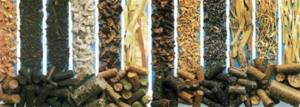
Pellets are compressed biomass that has a certain energy value. The most in demand today are wood pellets. They have a number of advantages over conventional firewood.
Pellets solve the problem of recycling wood waste, and are also an environmentally friendly fuel.
In addition to wood pellets, there are the following types of pellets:
- vegetable granules (pressed sunflower husks, straw, etc.);
- peat granules;
- pressed coal;
- municipal solid waste.
Wood pellets have earned first place in the pellet rating due to a number of advantages:
- reducing the level of environmental pollution with carbon dioxide;
- reducing the amount of sulfur dioxide emissions;
- the risk of fire due to fuel spillage is reduced to zero;
- greater heat transfer compared to boards, chips or bark;
- compactness in storage;
- the possibility of placing pellets next to any residential premises, due to the lack of biological activity of pellets;
- the possibility of making wood pellets with your own hands.
Fuel pellets differ in their purpose: fuel for industrial purposes is of lower quality; granules for home use, in turn, contain less bark and a lower percentage of ash content.
